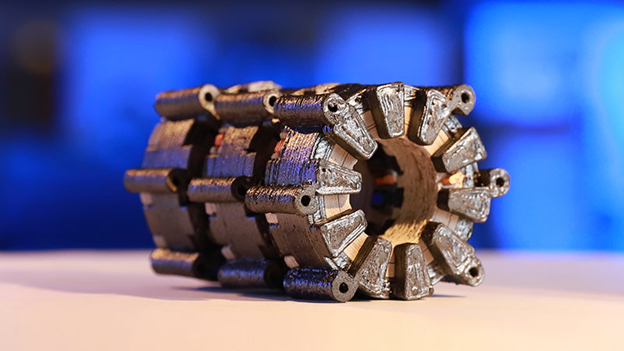By Heather Hamilton, contributing writer
Since 2012, Chemnitz University of Technology in Germany has actively researched additive manufacturing for electric motors. By layering and then sintering the materials, researchers have successfully manufactured all required motor components in a lab through a proprietary 3D-printing process that utilizes copper, iron, and ceramic pastes.

Stators of the first 3D-printed electric machine. Photo: TU Chemnitz/Jacob Müller.
These include “copper electrical conductors, which create magnetic fields in combination with iron or iron alloys, and ceramic electrical insulation, which insulates the conductors from each other and from the iron components,” said the researchers.
Doctor and professor Ralf Werner and research assistants Johannes Rudolph and Fabiana Lorenz initially presented a 3D coil in 2017, which was capable of withstanding temperatures over 300°C. “The goal of about two-and-a-half years of work has been to shift the limit of the operating temperature of electrical machines significantly upwards,” said Werner in a press release.
According to researchers, viscous pastes are extruded through a die that builds the 3D body in layers, offset with specialized binders (which are later expelled as the metallic and ceramic particles fuse together) depending on the body shape of the printed material. The researchers add that the reduction in volume must be considered when building the CAD data and that the heat treatment results in a solid body with low residual porosity.
The 3D multi-material process allows for several materials to be used simultaneously while something is being printed, which provides for a greater variety of desirable characteristics like heat resistance and thermal conductivity. The process also allows for self-supporting structures, which means that it can be used to print structures with both closed and empty cavities, which can allow for passive and active cooling.
The use of ceramic materials, as opposed to more traditional polymer-based materials, affords a greater temperature resistance in which the upper temperature limit — at up to 700°C — is set by the iron.
“Despite a process-related, slightly reduced electrical conductivity of the copper, it is also possible in special applications to increase the efficiency by significantly reducing the winding temperature,” said Lorenz in a press release.
Researchers said that with the addition of additional support structures, they’ll be able to print almost any 3D shape with high material efficiency. And, while the team presented additional details at Hannover Messe in April, they’re now developing the motor for series production for use in engineering, automotive, and aviation industries.
Advertisement
Learn more about Electronic Products Magazine





